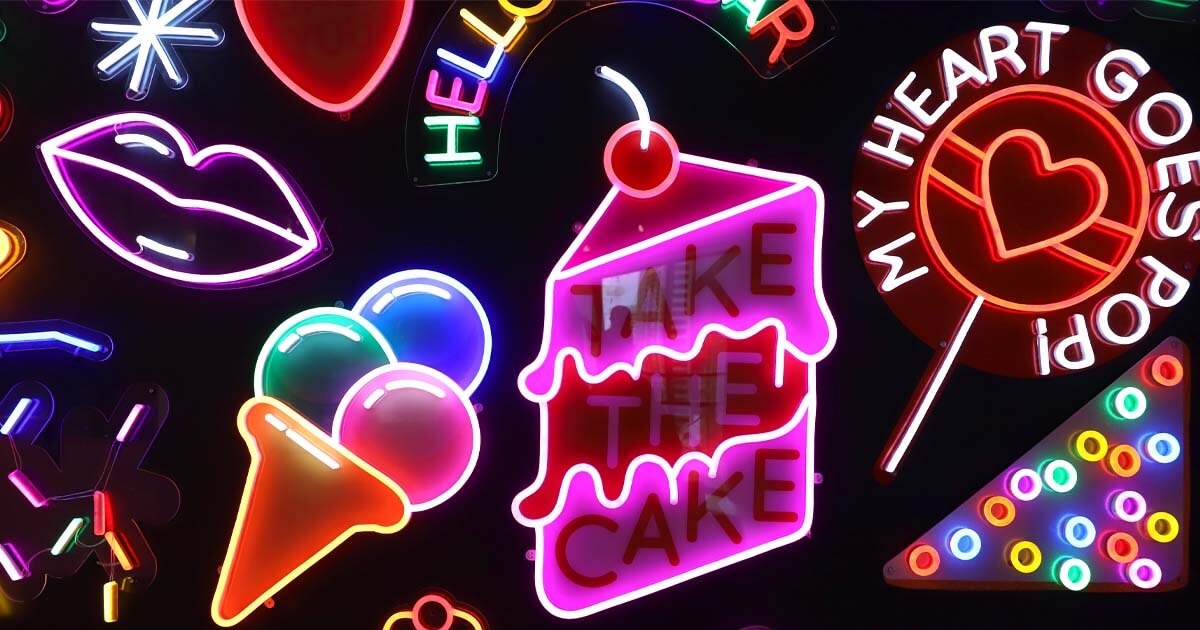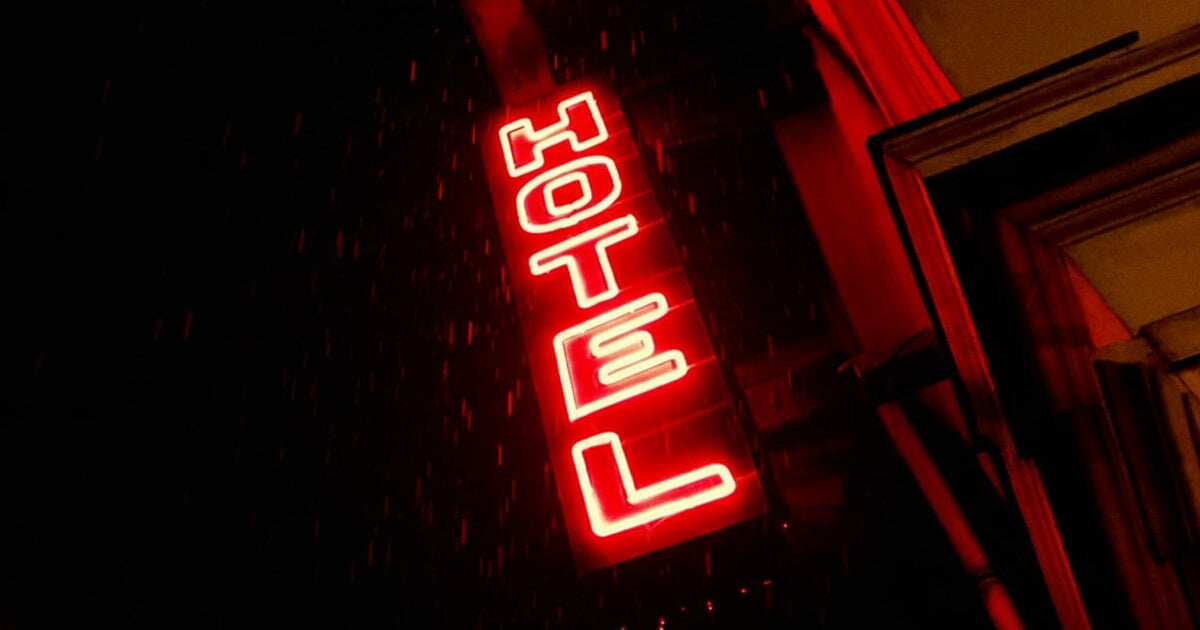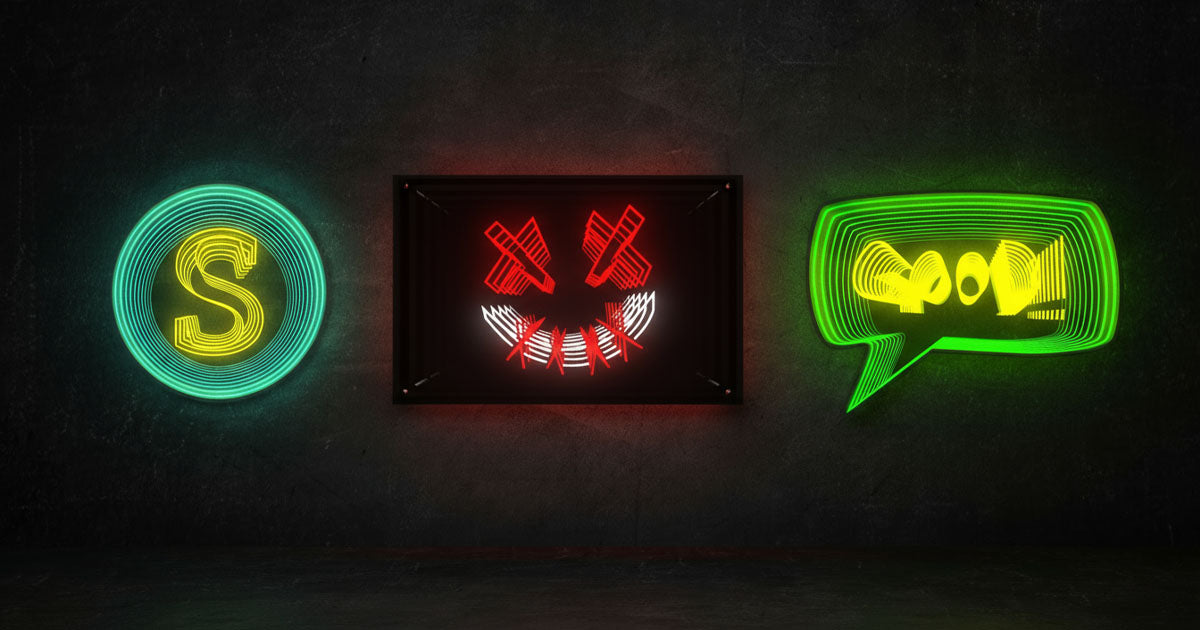 LED neon signs have become extremely popular because of their bright colors and versatile designs. Unlike traditional glass neon signs, these modern versions use advanced technology to combine the appeal of neon lighting with greater flexibility, offering a one-of-a-kind visual experience.
LED neon signs have become extremely popular because of their bright colors and versatile designs. Unlike traditional glass neon signs, these modern versions use advanced technology to combine the appeal of neon lighting with greater flexibility, offering a one-of-a-kind visual experience.
Knowing about the parts that make up LED neon signs is important for a few reasons:
-
Ensuring Quality: Understanding the materials and construction techniques helps guarantee the sign's durability and performance.
-
Making Design Choices: Familiarity with the different components lets you make better decisions when personalizing a sign.
This article will explain the major components of LED neon signs, how they are made, and various customizations. Knowing how these signs are manufactured will help you choose or design your next custom LED neon sign.
We will also show the importance of each component in an LED neon sign for personal and business uses. This will further help you design a custom LED neon sign.
What Are LED Neon Signs?
LED neon signs are innovative lighting solutions that use technology to emulate the look of classic glass neon signs. While conventional neon is made with gas-filled glass tubes, modern
LED neon signs apply flexible tubing's of either plastic or silicone. This design enables more intricate shapes and configurations, enriching durability.
Benefits of LED Technology
-
Energy Efficiency: Low-voltage operation reduces energy consumption compared to high-voltage usage of traditional neon signs.
-
Durability: The materials of the LED neon signs are resistant to environmental factors and have greater strength than fragile glass. It increases the lifetime of the signs while reducing the costs of their maintenance.
Design Flexibility and Aesthetic Appeal
LED neon signs are way better in terms of design flexibility. Being lightweight, they are easy to install for several uses, from storefronts to home decoration. The bright colors make LED signs highly visible and are widely used by businesses to make them noticeable.
Understanding what LED neon signs are made of will help explain why they have advantages over other signs and can be customized to match customers' preferences.
Modern LED Neon Sign Types: Options and Comparisons
There are several types of modern LED neon signs available. Here are the main options available:
1. Flexible LED Neon Tubes
-
LED neon signs are made of flexible materials, which makes them easy to bend.
-
It is lightweight, easy to install, and ideal for any customization.
-
It is flexible, making them suitable for various uses and other creative applications.
2. Acrylic LED Neon Panels
-
These are made for signage that requires solid transparent backing, adding a more structured look.
-
Their design perfectly fits polished looks, ensuring professional presentation in commercial places.
-
Acrylic panels spread light evenly while staying strong and durable, making them perfect for signage.
 Each type of modern LED neon sign has advantages in the design world. The right choice depends on how you plan to use it, whether for artistic expression or professional branding.
Each type of modern LED neon sign has advantages in the design world. The right choice depends on how you plan to use it, whether for artistic expression or professional branding.
As technology improves, even more customization options will give users greater opportunities to create unique visual statements.
Key Components of LED Neon Signs
1. LED Tubing
LED Tubing is the visual element of an LED neon sign. It provides great illumination while creating a similar appearance to traditional neon lighting.
Material choice for this Tubing has a great output in terms of both flexibility and design capability.
LED Tubing Material:
-
Silicone Tubing: Very flexible, which means detailed forms and bends can be achieved. UV light and temperature resistance will make them last longer under any weather conditions. It is usually more durable than PVC, which reduces the chances of getting damaged during assembly or transport.
Our company is only using silicone tubing material to ensure its flexibility, resistance, good visual output and long life.
2. Copper Contact Pads
Copper contact pads are the main parts that connect electricity in any LED neon sign. They carry electric current along their length to maintain the design's consistent brightness.
Design Integration:
Copper contact pads built into the LED strip tubing are important for both function and looks in the signs. These small, visible copper areas on the LED strip's surface serve as electrical connectors, allowing you to connect the strip to a power source or link two cut sections together. They operate with low-voltage power supplies that change AC voltage into the usable 12V or 24V DC needed by LED systems.
Types of Copper Contact Pads:
There are various types of copper contact pad setups, each used for different design needs and applications. 2-pin setups are for single-color LED strips, needing only positive and negative connections. 4-pin setups are designed for RGB LED strips, featuring connections for red, green, blue, and common ground. Changing the copper contact pad setup changes the functionality and color options of the signs.
Safety Considerations:
High-quality copper contact pads help prevent overheating and ensure reliable electrical connections, thereby ensuring safe operation. These pads are designed to handle specific current levels, with connectors usually rated between 3.5A and 5A, depending on the connector type. When used together with proper wiring, connectors, and control systems, well-maintained copper contact pads help LED neon displays last longer.
 Understanding how copper contact pads work and how each part functions is important for ensuring the quality and durability of an LED neon sign.
Understanding how copper contact pads work and how each part functions is important for ensuring the quality and durability of an LED neon sign.
3. Power Supply
The power supply is important in making LED neon signs work properly. The primary function of the power supply is to convert standard AC to the required DC for the LEDs. This shall do two major things:
-
It ensures a steady voltage is given to the LED tubing consistent with the sign's brightness.
-
The LEDs are optimized in performance for a longer useful life while being energy-efficient.
Power supplies absorb voltage fluctuations, protecting other important components like copper contact pads, mounting hardware, and several connectors and accessories from potential damage.
 Other components, such as transformers, may be added to ensure more stable performance further. Such transformers ensure operations remain within proper specifications, especially in large or complex installations of LED neon signs.
Other components, such as transformers, may be added to ensure more stable performance further. Such transformers ensure operations remain within proper specifications, especially in large or complex installations of LED neon signs.
Knowing how a power supply works to make high-quality, long-life LED neon signs enhances its service life and visual look.
4. Transformers (if applicable)
Transformers are very important in LED neon signs, mainly in those cases that require higher voltage for the execution of their operation. And here's what they do:
-
Regulate Voltage: Transformers maintain the supply of voltage, which otherwise may fluctuate and, therefore, cause a change in the sign's performance.
-
Enhance Safety: Controlling the flow of electricity reduces the chance of damage to components such as LED Tubing, copper contact pads, and wiring.
Though most LED neon signs use low voltage directly from a power supply, transformer-based designs are required when there are many features or larger installation sizes.
They transform standard electricity into usable voltage inside the sign's internal parts. This regulation prevents damage to sensitive electronic parts and provides even brightness across the display.
Knowing how transformers work helps us purchase reliable, high-quality LED neon signage that meets all design goals regarding durability.
5. Mounting Hardware
Mounting hardware is very important when installing and stabilizing an LED neon sign. Different mounting solutions ensure that the sign is attached properly to walls or stands for the security and aesthetics of the unit. Key options include:
-
Standoffs create space between the sign and the wall to achieve a three-dimensional effect.
-
Hanging Kits are great for suspended installations; most kits include cables or chains for various display options.
The mounting hardware should comply with the sign's specific design needs, from the materials used, such as silicone or PVC tubing, to the LED Tubing.


If installed properly, its components, such as copper contact pads, power supplies, and all associated connectors and accessories, will serve their functions optimally in the overall performance of an LED neon sign.
This attention to detail is important in producing a well-produced LED neon sign that meets expectations according to design.
Read Also: Neon Sign Installation Guide: How to Mount or Hang A Neon Sign
6. Wiring Quality
Safety and efficiency, in general, depend on good wiring connections within an LED neon sign. It interconnects electrical components, including:
-
LED Tubing
-
Copper Contact Pads
-
Power Supply
-
Transformers
-
Control Systems
Poor wiring can allow it to flicker, stay at low brightness, or not work.
Wiring quality considerations:
-
Material: Durable materials will not deteriorate over time.
-
Gauge: Proper wire gauge that conducts current without overheating.
-
Connections: Sturdy and insulated connections further reduce any possibility of short circuits.
Poor wiring negatively affects the lifespan of an LED neon sign. Therefore, good-quality wiring is one of the main contributors to creating a high-quality, aesthetically and functionally acceptable sign.
7. Connectors and Accessories
Connectors and accessories are crucial in making LED neon signs work properly and be stable. They ensure a safe electrical connection and proper assembly. The major types are listed below:
-
Clips: These hold up the LED Tubing to a back panel or a wall while maintaining the sign in shape and position for its support.
-
End Caps: Seals both of the LED Tubing ends to prevent dust and moisture from entering into the signs to increase their lifespan.
 The performance of an LED neon depends on the quality of the connector. Good-quality connectors ensure sustained electric flow from the power supply across the copper connector pads, maintaining consistent brightness across the whole sign.
The performance of an LED neon depends on the quality of the connector. Good-quality connectors ensure sustained electric flow from the power supply across the copper connector pads, maintaining consistent brightness across the whole sign.
Connectors are fitted with several materials utilized in LED tubing, including silicone and PVC. It ensures increased flexibility in design as installations become easier.
As mentioned above, all these components will play an important role in creating a superior LED neon sign that combines aesthetics with functionality.
8. Control Systems (if applicable)
Advanced controlling systems bring a new dimension of functionality and aesthetics to LED neon signs. This can only open up various possibilities for customizing your signage experience, from color changes to dynamic patterns.
Key features include:
-
Programmable Functions: Users can set up display colors or patterns at different times to attain a unique visual effect that suits various occasions.
-
Remote Operation: Most LED neon signs come with a remote control, which allows for easy adjustments in a very comfortable way without necessarily accessing the sign.
-
Integration Capabilities: Some can be integrated with smart house technologies where automation can be done with time or events.
 Advanced control systems increase versatility and make every sign an interactive decoration for its users.
Advanced control systems increase versatility and make every sign an interactive decoration for its users.
How Are LED Neon Signs Manufactured? Production Process Explained
The manufacturing process for LED neon signs involves several processes that ensure the output will be high quality.
1. Designing the Layout
Manufacturing begins with the customer designing the sign using a neon sign customizer or making an electronic copy of the sign that the customer wants. The layout provides a pattern to be followed through the remaining production stages.
2. Shaping Flexible LED Tubing
Following the designs, flexible LED tubing is carefully molded and bent. This step is very important because it means delivering the look and appeal of traditional neon in a more robust and modern material. The Tubing's flexibility allows for detailed work that is impossible with glass.
3. Assembly and Testing
Assembled components undergo a series of functionality and quality tests. Before being packed and sent to customers, each LED neon sign must meet laid-down standards. This ensures that each product delivered to the customers will be reliable and meet their expectations.
The systematic procedure for designing and developing each particular model has thus enabled the LED neon sign manufacturer to achieve a similar appearance to traditional neon while improving durability and energy efficiency for contemporary sign applications.
What Are the Benefits of Using LED Neon Signs Compared to Glass Neon Signs?
LED neon signs have a lot of advantages over glass neon signs. Here are the main benefits:
 1. Energy Efficiency
1. Energy Efficiency
They can use at least 80% less power than a glass neon sign. The high reduction, therefore, would be minimally reflected in the electricity bills, which encourages going green in signage.
2. Durability and Safety
Made from shatter-resistant materials, the LED neon signs are more durable compared to the glass-made traditional neon signs. For this reason, they are much safer for many kinds of environments and have a higher probability of breakage.
3. Design Flexibility
LED technology provides a broader color palette and more shapes than can be printed. It further expands the design options, enabling customized, unique-looking signs perfect for particular looks or branding needs.
4. Noise-Free Operation
Unlike traditional glass neon signs, which can sometimes produce a soft humming sound, LED neon signs operate silently. They are, therefore, suitable for noise-sensitive environments, such as in the office, bedroom, or quiet retail outlet.
5. Hassle-Free Installation
Their light materials and flexible design make them easy to install on a variety of surfaces without involving any professional assistance. LED neon signs have pre-drilled holes or mounting brackets, facilitating easy and time-and-money-saving Do-It-Yourself installations.
6. Lightweight and Portable
Unlike glass-made neon signs, LED neon signs can be moved without the fear of breakage. LED neon sign flexibility is ideal for businesses that change their position from time to time and for houses that are likely to move from one room to another.
7. Standard Wall Outlet Compatibility
Most LED neon signs plug into any standard wall outlet, requiring no special electrical work. Of course, such a plug-and-play system makes setup and placement so much easier since you're not worrying about outlet compatibility.
8. Adjustable Brightness / Dimming Capabilities
Most LED neon signs feature adjustable brightness, which you can dim during nighttime or the less busy part of the day. It comes in handy when creating that perfect ambiance – one moment very bright and striking, the next moment soft and subtle.
9. RGB Color-Changing Options
This feature allows one to switch their LED neon signs among colors or create dynamic color patterns. The RGB feature is excellent for businesses and homeowners who like changing their neon sign color according to the time of year or their mood.
For all these reasons, the LED neon sign is one of today's solutions that retains the aesthetics of traditional neon signs.
Considering their strength and versatility, they may be used in outdoor and indoor requirements, thus increasing their value in the sign industry.
How Energy Efficient Are LED Neon Signs?
LED neon signs use much less electricity than traditional neon signs. Lower electric consumption means lower electricity costs, making them appealing for businesses or home decor.
 Main factors that prove the efficiency of LED neon signs:
Main factors that prove the efficiency of LED neon signs:
-
Reduced Electricity Consumption: Compared with traditional neon, LED neon signs consume about 80% less electricity, thus saving money on energy bills.
-
Extended Operational Hours: Because it is very efficient, the hours of consumption are extended for more prolonged use without abruptly changing the expense on energy costs. That fact makes the application of LED neon signs budget-friendly in commercial and residential lighting.
-
Long Lifespan: Averaging about 50,000 to 100,000 hours or more, in some cases, saves on electricity costs and reduces the number of times one can replace them; this contributes to efficiency by minimizing waste and effort in restoring or replacing.
Besides the cost-saving benefits, durability and sustainability make LED neon signs even more attractive as a modern lighting medium. Their long life and low energy consumption make them stand out as a prospective alternative for signage.
How Long Do LED Neon Signs Last?
Most LED neon signs have a long life span, lasting between 50,000 to 100,000 hours, whereas the traditional glass neon signs usually would have to be changed in comparably lesser periods. Following is an overview of factors that may impact the lifespan of a neon LED sign.
 Factors That Affect the Lifespan of LED Neon Signs
Factors That Affect the Lifespan of LED Neon Signs
-
Usage: Signs turned on continuously will wear out differently than those used only occasionally.
-
Environmental Conditions: Very high or low temperatures, moisture, and/or direct sunlight may affect the life span of all the sign's components.
-
Quality of Components: The quality of the materials and construction used will also decide the lifespan of the neon LED sign.
An LED neon can last several years if well cared for and maintained. Regular cleaning and optimal environmental conditions will add to its lifetime. Long durability and low maintenance costs equate to a cost-effective solution provided by an LED neon sign.
Investing in high-quality components makes the sign look superb and contributes to its long-lasting characteristics. Such factors may be advantageous when choosing LED neon signs for particular needs and usage situations.
Customization Options for Your Own Unique Sign
Customizing your neon sign has also become popular among businesses and people who want unique branding identifiers or gesture gifts. In custom LED neon signs, you can able to have the following variations:
-
Tailored Shapes: Flexibility in design allows for the return of more intricate shapes representative of an owner or a brand.
-
Color Choices: Color variations may be chosen according to specific themes or preferences, which adds more aesthetic value.
-
Size Variations: Choosing from custom sizes enables signs to fit in different spaces and be used where intended.
 Neon sign customization makes the signs unique, memorable, and effective. Understanding this assists in getting the desired or needed look.
Neon sign customization makes the signs unique, memorable, and effective. Understanding this assists in getting the desired or needed look.
Key Takeaways of Knowing LED Neon Sign Components
Knowing the components of LED neon signs helps show appreciation for their durability and energy efficiency. Knowledge of the materials will lead to selecting a high-quality product with long-term working performance.
The key essentials that must be taken into consideration are:
-
Durability and Energy Efficiency: Knowing the various components used—flexible silicone or PVC tubing, for instance—will give you a genuine appreciation for how much longer LED neon signs last and how much less power they use than glass neon signs.
-
Quality Selection: By knowing the different parts of LED neon signs, you can make smart choices when you buy them. Remember to ask about the product's quality parts, like whether it has a stable power supply and high-grade wiring.
-
Design Flexibility: If you know how the LED neon signs are made, you'll better understand the design. Since they are made by order, this is a great way to brand your business or give a personalized gift to someone.
Knowing these factors will allow you to maximize the benefits of LED neon sign materials, leading to creative and effective signage solutions.






Share: